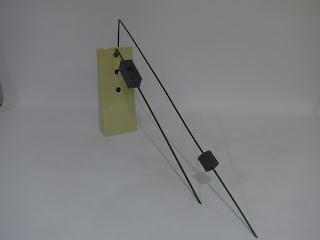Hello everyone,
Last week our group held its first meeting for the year which included its AGM and a workshop lead by Betty and Toula Karanikolopoulos, my sisters-in-law. The theme for the workshop was 'An arrangement combining panty hose and wire in a sculptural form'. The girls made a number of quite amazing and creative pieces. Unfortunately, due to grandparenting duties, I had to leave the workshop early and didn't take any photographs. I would strongly encourage you to go to our website at sogetsuikebanavic.weebly.com for all the photographs.
I really enjoyed playing with these materials and made the piece below.
The brief also indicated that we were to use a vase and fresh materials to complete the piece but I felt mine didn't need it. However, in order to comply with the brief, I tried a number of flowers and leaves and finally settled on the amaranthus in a square, white container. I still feel it looks better without it. What do you think?
I couldn't even throw the scraps away, hence the playful piece below. The hosta leaves and flower are from a plant that was given to me by my colleague Lee Johnstone many years ago but has only just flowered, so had to be used.
Recently my sisters and I had occasion to visit the
garden of Glenda Nielsen. I have known Glenda for a long time through our
mutual love of our respective floral art and our appreciation of each other's work. We have, also, collaborated in doing
the flowers in a couple of weddings. I'm not able to enumerate all of Glenda's
achievements in floral art but, suffice to say, she has dedicated her life to it
in all its forms including acting as judge for many years. She is now retired
but, clearly, has not stopped gardening or practicing her floral art.
Glenda's garden, when seen from the front, looks
deceptively small but is, in fact, quite long and narrow with something of
interest at every turn, including a glass house at the end. It is definitely a
floral artist's garden, rich in material for her use.
The garden also has a very generous owner. No sooner did
we show some interest in a particular plant, than Glenda would pick up a shovel
and dig some up for us. There were many interesting plants but, for us, the
piece de resistance was the viburnum setigerum with its glorious berries that
look like they're made of glass. All in all, a very pleasant afternoon. Thank
you Glenda.
 |
| Glenda in front of her viburnum setigerum |
 |
| A close-up of the berries of vibunum setigerum |
In preparation for my trip to Okinawa next month for the Ikebana International convention, I needed birds nest ferns with which to practice. Two very kind ladies provided me with this precious resourse - my student Shaneen Garbutt and colleague Lee Johnstone. With the leftovers I created this wall arrangement.
Bye for now and stand by for my next post. I have something special to share with you.
Emily


































